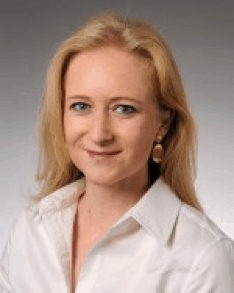Financial Inclusion Week: Reflection and Action from Three Leading Voices
Today, the Center for Financial Inclusion (CFI) is wrapping up Financial Inclusion Week. The intention for the week was to ask some soul-searching questions about what it means to be inclusive: to take “a step back as a community to revisit the fundamental purpose of our work,” as CFI put it.
These aren’t just issues of semantics, but questions that affect not just the bottom lines of providers, but also the lives of millions of customers and their families. With financial technology weaving its way into so many aspects of life in low- and middle-income countries, the potential for good – and for harm – is moving at a rapid pace. We caught up with three leading voices in the field, asking them the same set of three questions focused on what financial inclusion truly means to them from a personal, organizational and international standpoint.
Laura Hemrika, Global Head, Corporate Citizenship at Credit SuissE and EUROPEAN MICROFINANCE PLATFORM CHAIRWOMAN

Laura Hemrika
1. The description of the theme of this year’s Financial Inclusion Week mentions that “This year, we are taking a step back as a community to revisit the fundamental purpose of our work, and ask ourselves what is financial inclusion for?” Why does it seem important to step back and reassess such a fundamental question at this particular time in the sector’s development?
Over the years there have been many statements, both positive and negative, about the effectiveness and impact of financial Inclusion. It’s important and transparent to identify financial inclusion as a means to an end, a tool alongside several others that are needed for individuals and households – and eventually communities and countries – to develop socially and economically. To measure the impact and effectiveness of the sector and help it develop further, we need to articulate the limitations and opportunities so that the best partnerships, interventions and approaches can be invested in – and the end clients are offered products and services that meet their needs.
2. What’s your personal response to the question: “What is financial inclusion for?”
For me, at a very personal level, it has always been about freedom – the freedom for people to make their own decisions, whether to build a business, provide their children with an education, or pay for health care, medication or a safe home – and the freedom that these decisions can be made by individuals if and when they need to. This reality is still far off for many.
3. How will your organization’s response to that question shape its work/strategies in the coming year – specifically, what (if anything) will you do differently?
At Credit Suisse we focus both on grant-funded capacity building and private capital investment in financial inclusion via MIVs and other vehicles. A few years ago we focused our capacity building on the development of more diverse products and services (housing finance, education finance, services for women, development of new fintech solutions, etc.) within MFIs, and complementing this with investment vehicles to finance further growth in these different topics. We will continue to build on that basis, but will also look at how we can ensure that technology and gender factors are taken into consideration across new products and services responsibly, whether (for example) within MFIs which still need to embrace technology more effectively, or in fintechs where gender still needs to be brought to the forefront. Further articulating the role of financial inclusion (and impact investment in financial inclusion) within the SDGs will continue to be an important part of our communication work.
Jurgen Hammer, Managing Director at SPTF
1. The description of the theme of this year’s Financial Inclusion Week mentions that “This year, we are taking a step back as a community to revisit the fundamental purpose of our work, and ask ourselves what is financial inclusion for?” Why does it seem important to step back and reassess such a fundamental question at this particular time in the sector’s development?

Jurgen Hammer
The ongoing technological disruption affects every aspect of our lives and every sector of our economy and has of course also entered the financial inclusion space (“fintech”) with shining promises: efficiency gains leading to lower costs, lower interest rates charged to clients, better outreach to the remote, rural and other continuously excluded, and so many more.
Fintech promises a level of financial inclusion that traditional microfinance did not achieve, and at first glance the numbers of new customers seem to prove its success: ever more accounts opened and clients registered. But markets such as Kenya, frontrunners in the fintech space, show a very different reality.
We are facing many fintech-driven risks: high prices, over-indebtedness, the digital divide, and tens of thousands of people negatively listed for tiny loans. Funding is pouring into the space and questions have been raised over the prudence of some of these investments. Regulators haven’t kept pace. Experience in Kenya and other countries points to the urgency to take a step back NOW and reassess the fundamental question: “What/who is this for?”
The objective is not inclusion for the sake of inclusion. Inclusion must be driven by our desire to create value for the client. This objective requires us to understand the opportunities and risks of financial services in line with our clients’ specific needs, situations and demands.
2. What’s your personal response to the question: “What is financial inclusion for?”
I don’t like to think about financial inclusion en masse. If our focus is on the needs of individual customers, the rest will fall into place. The range of financial services a person needs depends on their individual needs. Our focus must shift from supply side variables toward a laser focus on what customers need and want. If you think about why a customer is using financial services, it is not so they will be included—it is so they can achieve something they need: getting an education, insuring their family, sending money home. As these examples demonstrate, financial inclusion is a means to an end, and not an end to itself.
This also shows the required complexity in the development of efficient financial services. The end is the customer, and therefore there’s an absolute necessity to put him/her in the center, at every step.
3. How will your organization’s response to that question shape its work/strategies in the coming year – specifically, what (if anything) will you do differently?
The SPTF was created to be the voice of ethics, responsibility and impact for the microfinance industry. At its inception in 2005, these were fringe concepts, and we spent much of our time simply preaching the importance of a double bottom line. As our message took hold, we made progress: With incredible industry input, we developed standards for balanced performance management, tools for executing best practice, and a global community of people willing to share their successes and failures.
These standards — the Universal Standards for Responsible Inclusive Finance — remain the foundation of everything we do. In the coming year, two important focus areas are customer empowerment and customer outcomes.
Our Customer Empowerment Working Group develops practical guidance at the provider and market level to support customer empowerment. We believe that in an increasingly digital market, it is more important than ever that customers have the capability (knowledge, skills, confidence, etc.) to make good decisions and engage with providers to shape services to their own needs. It also means that structures at the provider and market level do not block – and hopefully enable – customers, putting this capability into practice.
In the area of customer outcomes, the SPTF Outcomes Working Group endeavours to provide the industry with reliable data on the types of changes that financial inclusion can affect in clients’ lives, how long it takes to achieve those changes, and what magnitude of change is reasonable to expect. Eventually, we seek to define standards for client outcomes for the industry in the same way that we have created standards for responsible inclusive finance.

Daniel Rozas
Daniel Rozas, Senior Microfinance Expert at the European Microfinance Platform
1. The description of the theme of this year’s Financial Inclusion Week mentions that “This year, we are taking a step back as a community to revisit the fundamental purpose of our work, and ask ourselves what is financial inclusion for?” Why does it seem important to step back and reassess such a fundamental question at this particular time in the sector’s development?
Financial inclusion is at a crossroads, a time of choices. Top-most among them is digital transformation, which poses a critical challenge to institutions that have evolved under a model that has always relied on the human touch as its cornerstone. The digital revolution has already upended sectors like journalism, communications and news – and not always for the better. It is already changing the financial industry. Institutions can choose to go with the dazzle of technology unbound, and risk their core mission in the process. They can try to ignore the change and slide into irrelevance. Or they can be both mission-focused and flexible, deploying new and exciting tools in a way that helps further their mission. The new digital landscape will feature plenty of financial products, but only those who design them to serve the client – and not the institution or its shareholders – will succeed in fulfilling their financial inclusion mission.
2. What’s your personal response to the question: “What is financial inclusion for?”
Financial inclusion, put simply, is a helper. Like a transport network, it doesn’t make people smarter, healthier, happier or wealthier. But it creates new opportunities. Some opportunities can lead to a better life, and some not. Some might even make things worse. And so, financial inclusion must be more than just the roads. It also needs clear and appropriate rules, along with a dependable police to enforce them. The rules cannot be so stifling as to slow traffic to a crawl, but they need to be sensible. And when accidents happen, emergency services should be in place to limit the damage. With those in place, financial inclusion can fulfill its promise of providing opportunities, while minimizing – and managing – the inevitable downside risks.
3. How will your organization’s response to that question shape its work/strategies in the coming year – specifically, what (if anything) will you do differently?
We at e-MFP are continuing to further our goal to link together the financial inclusion community. Through the European Microfinance Award, we will continue to highlight areas in the sector that are too often neglected, but where innovation thrives and needs to be more broadly shared. And with our new Financial Inclusion Compass, we are building a resource that draws on the wisdom of a deep and global bench of experts, to clarify the trends and new areas of interest to guide the sector in an ever-changing landscape. Finally, we will continue to bring people together – and not just during the European Microfinance Week – convening the right people at the right time and the right place in order to facilitate the discussions and collaborations that can help the sector address its most critical challenges.
James Militzer is the editor of NextBillion.
- Categories
- Finance, Impact Assessment, Investing, Technology



